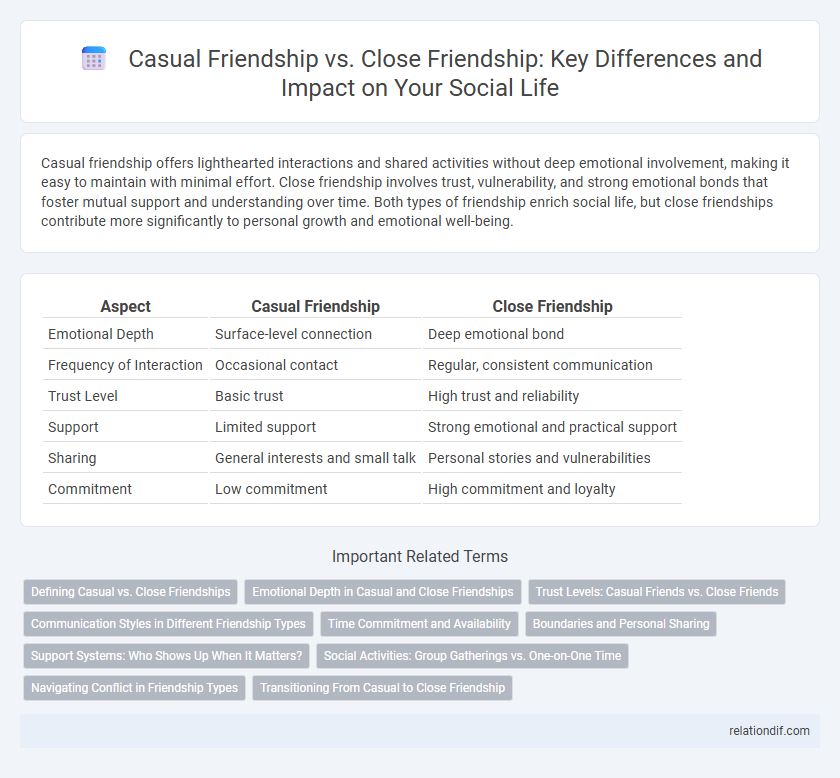Casual friendship offers lighthearted interactions and shared activities without deep emotional involvement, making it easy to maintain with minimal effort. Close friendship involves trust, vulnerability, and strong emotional bonds that foster mutual support and understanding over time. Both types of friendship enrich social life, but close friendships contribute more significantly to personal growth and emotional well-being.
Table of Comparison
| Aspect | Casual Friendship | Close Friendship |
|---|---|---|
| Emotional Depth | Surface-level connection | Deep emotional bond |
| Frequency of Interaction | Occasional contact | Regular, consistent communication |
| Trust Level | Basic trust | High trust and reliability |
| Support | Limited support | Strong emotional and practical support |
| Sharing | General interests and small talk | Personal stories and vulnerabilities |
| Commitment | Low commitment | High commitment and loyalty |
Defining Casual vs. Close Friendships
Casual friendships typically involve acquaintances with limited emotional depth and infrequent communication, often formed through shared activities or social settings. Close friendships are characterized by profound emotional bonds, consistent support, mutual trust, and frequent, meaningful interactions. Understanding the distinction between these friendship types helps clarify expectations and the level of intimacy involved in each relationship.
Emotional Depth in Casual and Close Friendships
Casual friendships typically involve surface-level interactions with limited emotional depth, focusing on shared interests or activities without intense personal disclosure. Close friendships, in contrast, are characterized by deep emotional connections, trust, and vulnerability, allowing individuals to share personal struggles and joys. The emotional depth in close friendships fosters stronger bonds and greater support during challenging times.
Trust Levels: Casual Friends vs. Close Friends
Trust levels in casual friendships tend to be moderate, with individuals sharing surface-level information and relying on social interaction for companionship. Close friendships exhibit significantly higher trust, characterized by vulnerability, emotional support, and the confident sharing of personal experiences. This deeper trust fosters stronger bonds, promoting long-term loyalty and mutual understanding.
Communication Styles in Different Friendship Types
Casual friendships often rely on light, surface-level communication centered around shared activities and general interests, with infrequent and brief interactions. Close friendships feature deeper, more intimate communication, including personal disclosures, emotional support, and frequent, meaningful conversations. Differences in communication styles directly influence trust levels and emotional closeness between casual and close friends.
Time Commitment and Availability
Casual friendships typically require minimal time commitment, allowing individuals to engage sporadically without significant scheduling demands. Close friendships often demand greater availability, as they involve deeper emotional support and regular interactions. The quality of close friendships is maintained through consistent time investment, fostering trust and understanding over casual acquaintances.
Boundaries and Personal Sharing
Casual friendships typically maintain clear boundaries where personal sharing is limited to surface-level topics, preserving emotional distance. Close friendships involve deeper personal sharing, fostering trust and emotional intimacy while respecting each other's vulnerabilities. Clear communication of boundaries in both types helps maintain healthy relationships based on mutual understanding and comfort.
Support Systems: Who Shows Up When It Matters?
Casual friendships often provide light social interactions and occasional fun, but close friendships serve as vital support systems, offering emotional resilience during life's toughest moments. Close friends consistently show up with empathy, reliability, and understanding, creating a foundation of trust that casual connections usually lack. This dependable presence in times of crisis distinguishes close friendships as essential pillars for mental health and personal growth.
Social Activities: Group Gatherings vs. One-on-One Time
Group gatherings in casual friendships foster social interaction through shared activities, creating a dynamic environment with multiple acquaintances. Close friendships prioritize one-on-one time, allowing deeper conversations and emotional bonding away from larger social distractions. Engaging in different social activities shapes the intensity and quality of the friendship experience.
Navigating Conflict in Friendship Types
Casual friendships often handle conflicts with surface-level communication, prioritizing convenience and low emotional investment, whereas close friendships require deeper emotional engagement and honest dialogue to resolve misunderstandings effectively. Conflict navigation in close friendships involves empathy, vulnerability, and a willingness to repair trust, strengthening the bond over time. Understanding these dynamics helps individuals tailor their conflict resolution strategies to maintain healthy relationships across varying friendship types.
Transitioning From Casual to Close Friendship
Transitioning from casual to close friendship involves increased trust, shared experiences, and emotional vulnerability that strengthen the bond beyond surface-level interactions. Consistent communication and mutual support during challenging times help deepen connection, transforming acquaintanceship into a resilient, intimate relationship. Recognizing and respecting boundaries while fostering openness allows the gradual evolution from casual to close friendship.
casual friendship vs close friendship Infographic

 relationdif.com
relationdif.com